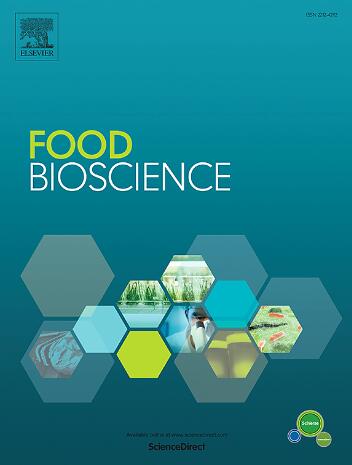Development and optimization of thyme-pennyroyal essential oils based active nanostructured lipid carrier (NLC) containing saffron extract with antioxidant and antimicrobial properties
IF 4.8
1区 农林科学
Q1 FOOD SCIENCE & TECHNOLOGY
引用次数: 0
Abstract
The saffron extract-loaded nanostructured lipid carrier (NLC) was synthesized by the double emulsion (W/O/W) method for application as a preservative to increase the oxidative and microbial stability of French dressing. The optimization of the NLC system was carried out using a combined D-optimal design methodology and effect of thyme (TEOs)/pennyroyal (PEOs) essential oils, and polyglycerol ester (PGE)/polyglycerol polyricinolate (PGPR) surfactants ratios (independent variables) were investigated on the mean particle size, polydispersity, zeta potential, and encapsulation efficacy (dependent variables). The optimal formulation (NLC opt) was obtained as 90/10 thyme/pennyroyal essential oils and 90/10 polyglycerol esters/polyglycerol polyricinoleate ratio, which resulted in the lowest PDI and particle size (0.38 and 66.87 nm respectively), highest zeta potential and encapsulation efficiency (−26.7 mV and %78.88 respectively). Different techniques including transmission electron microscopy (TEM), Fourier transform-infrared spectroscopy (FTIR), differential scanning calorimetry (DSC), and X-ray diffraction (XRD) analysis were used for the characterization of structure and physicochemical properties of the different NLC systems and confirmed successful incorporation of SE into NLC. The DPPH test showed decrement of antioxidant activity during 30 days of storage and IC value was lower in the SE-NLC (0.68 mg/ml) than in the free extract. The minimum inhibitory concentration (MIC) and minimum bactericidal concentration (MBC) tests against , and indicated that the SE did not have antibacterial properties. However, NLC formulations showed antimicrobial effect due to the presence of TEOs and PEOs essential oils. Peroxide value of control sample was the highest (8/35 O/kg) and it was the lowest (3.75 O/kg) in French dressing with SE-NLC.开发和优化基于百里香-凤仙花精油的活性纳米结构脂质载体(NLC),其中含有具有抗氧化和抗菌特性的藏红花提取物
采用双乳液(W/O/W)法合成了藏红花提取物负载纳米结构脂质载体(NLC),并将其用作防腐剂,以提高法式调味品的氧化稳定性和微生物稳定性。采用 D-optimal 设计方法对 NLC 系统进行了优化,并研究了百里香(TEOs)/茜草(PEOs)精油和聚甘油酯(PGE)/聚甘油三酸酯(PGPR)表面活性剂比例(自变量)对平均粒径、多分散性、ZETA 电位和包封效果(因变量)的影响。最佳配方(NLC opt)为百里香/麝香草精油比例为 90/10,聚甘油酯/聚甘油缩水甘油酯比例为 90/10,因此 PDI 和粒径最小(分别为 0.38 和 66.87 nm),zeta 电位和封装效率最高(分别为 -26.7 mV 和 %78.88)。透射电子显微镜(TEM)、傅立叶变换红外光谱(FTIR)、差示扫描量热仪(DSC)和 X 射线衍射(XRD)分析等不同技术被用于表征不同 NLC 系统的结构和理化性质,并证实 SE 成功地融入了 NLC 中。DPPH 测试表明,在 30 天的储存过程中,SE-NLC 的抗氧化活性下降,IC 值(0.68 mg/ml)低于游离提取物。最低抑菌浓度(MIC)和最低杀菌浓度(MBC)测试表明,SE 不具有抗菌特性。然而,由于 TEOs 和 PEOs 精油的存在,NLC 配方显示出抗菌效果。对照样品的过氧化值最高(8/35 O/kg),而添加了 SE-NLC 的法式敷料的过氧化值最低(3.75 O/kg)。
本文章由计算机程序翻译,如有差异,请以英文原文为准。
求助全文
约1分钟内获得全文
求助全文
来源期刊

Food Bioscience
Biochemistry, Genetics and Molecular Biology-Biochemistry
CiteScore
6.40
自引率
5.80%
发文量
671
审稿时长
27 days
期刊介绍:
Food Bioscience is a peer-reviewed journal that aims to provide a forum for recent developments in the field of bio-related food research. The journal focuses on both fundamental and applied research worldwide, with special attention to ethnic and cultural aspects of food bioresearch.
 求助内容:
求助内容: 应助结果提醒方式:
应助结果提醒方式:


